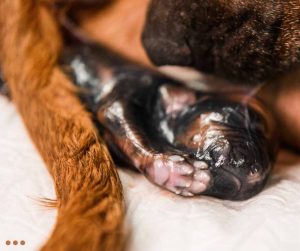Bringing a new furry family member into your home is an exciting and joyous occasion, but it also requires careful planning and preparation. In this article, I will provide you with all the necessary information on how to help your dog go into labor at home. From creating a comfortable birthing space to knowing the signs of labor. So, let’s dive in and get ready to welcome your new bundle of joy into the world!

Understanding the Signs of Labor in Dogs:
Table of Contents
As a dog owner, it is important to be aware of the signs of labor in your furry companion. Just like humans, dogs also go through a labor process when they are about to give birth to their puppies. Understanding these signs can help you prepare for the arrival of the new puppies and ensure a smooth delivery for your dog.
Changes in Behaviour
The gestation period for dogs is typically around 63 days, but it can vary from 58 to 68 days. As your dog nears the end of her pregnancy, you may start noticing some changes in her behavior and physical appearance. These changes are an indication that your dog is getting ready to give birth.
Decrease of Appetite
One of the first signs of labor in dogs is a decrease in appetite. As the puppies grow and take up more space in the uterus, there is less room for food. This can cause your dog to eat less or even refuse to eat altogether. However, it is important to continue offering small meals to your dog to ensure she is getting the necessary nutrients for the labor process.
Nesting behavior
Another sign to look out for is nesting behavior. This is when your dog starts to create a comfortable and safe space for her puppies. She may start to gather blankets, towels, or even shred paper to make a nest. This behavior usually occurs a few days before labor begins.
Restlessness
As labor approaches, your dog may also become more restless and start pacing or panting. She may also start to lick her genital area more frequently. This is a natural instinct to keep the area clean for the delivery of the puppies.
Water Breaks
One of the most obvious signs of labor is when your dog’s water breaks. This is when the amniotic sac ruptures, and you may notice a clear or slightly bloody discharge from your dog’s vulva. This usually happens right before the first puppy is born.
Contractions
Once labor begins, your dog will start having contractions. These contractions will become more frequent and intense as the labor progresses. You may notice your dog straining, and she may even vocalize during contractions. This is completely normal and is a sign that the puppies are on their way.
It is important to note that every dog is different, and the signs of labor may vary. Some dogs may show all of these signs, while others may only show a few. It is essential to monitor your dog closely and contact your veterinarian if you have any concerns.
If you are wondering how to help your dog go into labor at home, the best thing you can do is provide a calm and comfortable environment for her. Make sure she has a quiet and private space to give birth, and keep other pets and children away. You can also offer her some gentle massage and reassurance to help her relax.
In some cases, a dog may experience difficulties during labor and may require medical intervention. If your dog has been in labor for more than 24 hours without delivering any puppies, or if she is showing signs of distress, it is important to seek veterinary care immediately.
Creating a Comfortable and Safe Birthing Environment for Your Dog
Welcoming a new litter of puppies into the world is an exciting and joyous experience for any dog owner. As your dog’s due date approaches, it is important to create a comfortable and safe birthing environment for her. This will not only help her feel at ease during labor, but also ensure the safety and well-being of both the mother and her puppies. In this article, we will discuss how to help your dog go into labor at home and how to create a comfortable and safe birthing environment for her.
Preparing the Space:
The first step in creating a comfortable and safe birthing environment for your dog is to prepare the space where she will give birth. Choose a quiet and secluded area in your home, away from any noise or distractions. This will help your dog feel calm and relaxed during labor. Make sure the room is warm and well-ventilated, as a cold or stuffy environment can be uncomfortable for your dog.
 Providing a Comfortable Bed:
Providing a Comfortable Bed:
Next, you will need to provide a comfortable bed for your dog to give birth on. This can be a large cardboard box lined with clean towels or blankets. The box should be big enough for your dog to move around comfortably, but small enough to make her feel secure. Place the box in a warm and quiet corner of the room, and make sure it is easily accessible for your dog.
Creating a Calming Atmosphere:
During labor, your dog will be in a vulnerable and sensitive state. It is important to create a calming atmosphere to help her feel relaxed and at ease. You can do this by playing soft and soothing music in the background, using dim lighting, and speaking to your dog in a gentle and reassuring tone. Avoid any sudden movements or loud noises that may startle your dog.
Providing Adequate Nutrition and Hydration:
Before and during labor, it is important to provide your dog with adequate nutrition and hydration. Make sure she has access to fresh water at all times, and offer her small and frequent meals to keep her energy levels up. You can also give her some honey or glucose water to provide her with a quick boost of energy during labor.
Assisting Your Dog During Labor:
As your dog goes into labor, it is important to stay by her side and provide her with emotional support. You can gently stroke her and speak to her in a soothing voice to help her relax. If your dog seems uncomfortable or in pain, you can offer her a warm compress or a massage to help ease her discomfort.
Keeping the Area Clean and Sanitized:
During and after labor, it is important to keep the birthing area clean and sanitized. This will help prevent any infections or illnesses from affecting your dog and her puppies. Keep a supply of clean towels and blankets on hand to replace any soiled ones, and use a pet-safe disinfectant to clean the area.
Seeking Professional Help:
While most dogs are able to give birth without any complications, it is always a good idea to have a veterinarian on call in case of any emergencies. Keep your veterinarian’s contact information handy and be ready to take your dog to the vet if needed.
In conclusion, creating a comfortable and safe birthing environment for your dog is crucial for a successful and stress-free labor. By following these tips, you can help your dog feel at ease and ensure the safety and well-being of both the mother and her puppies.
Essential Supplies and Equipment for Assisting with Puppy Delivery at Home
Welcoming a litter of puppies into the world can be an exciting and rewarding experience. However, it is important to be prepared and have all the necessary supplies and equipment on hand to assist with the delivery process. Whether you are a seasoned breeder or a first-time dog owner, having the right tools and resources can make all the difference in ensuring a safe and successful delivery for both the mother and her puppies. In this article, we will discuss the essential supplies and equipment needed for assisting with puppy delivery at home.
Essential Supplies:
Clean towels and blankets
These will be used to keep the puppies warm and dry after they are born. It is important to have several on hand as they will need to be changed frequently.
Sterile scissors
These will be used to cut the umbilical cord of the puppies. Make sure they are clean and sharp to avoid any infections.
Dental floss or umbilical clamps
These will be used to tie off the umbilical cord after it is cut. Dental floss is a more affordable option, but umbilical clamps are specifically designed for this purpose.
Bulb syringe
This will be used to suction any fluids from the puppies’ nose and mouth to help them breathe.
Heating pad or heat lamp
Puppies are unable to regulate their body temperature, so it is important to have a heat source nearby to keep them warm. A heating pad set on low or a heat lamp placed at a safe distance can provide the necessary warmth.
Puppy milk replacer
In case the mother is unable to nurse or there are any complications, having a puppy milk replacer on hand can be a lifesaver for the newborns.
Scale
It is important to monitor the puppies’ weight gain in the first few weeks of their lives. A scale can help you keep track of their growth and ensure they are getting enough nourishment.
Whelping box
As mentioned earlier, a whelping box is a must-have for a safe and comfortable delivery. It should be large enough for the dam to move around and have low sides for easy access.
Gloves
It is important to wear gloves during the delivery process to prevent any infections or bacteria from being transferred to the puppies.
Flashlight
This will come in handy if the delivery happens at night or in a dimly lit area.
Thermometer
A thermometer can be used to monitor the dam’s temperature, which can indicate when she is about to go into labor.
Lubricant
This can be used to help ease the delivery process and prevent any tearing or discomfort for the dam.
Puppy pads
These can be placed under the dam to catch any fluids or mess during the delivery.
Preparing for Potential Complications During Labor and Delivery
Labor and delivery can be an exciting and nerve-wracking time for expectant mothers. While most deliveries go smoothly, it’s important to prepare for potential complications that may arise during this process. As a pet owner, it is also important to know how to help your dog go into labor at home. In this article, we will discuss some common complications that may occur during labor and delivery and how to prepare for them.
 Prolonged Labor or Dystocia
Prolonged Labor or Dystocia
During labor, a common problem is when it takes a long time, which is called prolonged labor or dystocia. This occurs when the labor process takes longer than expected, usually lasting more than 24 hours. Factors such as a large litter size, a small pelvic opening, or weak contractions can cause prolonged labor. If your dog is experiencing prolonged labor, it is important to seek veterinary assistance immediately. Your veterinarian may recommend a cesarean section to safely deliver the puppies.
Breech Birth
Another potential complication during labor is a breech birth. This occurs when the puppy is positioned in the birth canal with its hind legs or tail first instead of its head. Breech births can be dangerous for both the mother and the puppies, as it can cause difficulty in delivering the puppies and may result in oxygen deprivation for the puppies. If you notice that your dog is having difficulty delivering the puppies or if you suspect a breech birth, seek veterinary assistance immediately.
Uterine Inertia
Uterine inertia is another common complication during labor. This happens when the uterus doesn’t contract properly, making it hard for the puppies to be born. Uterine inertia can be caused by hormonal imbalances, stress, or a previous history of difficult deliveries. If your dog is experiencing uterine inertia, your veterinarian may administer oxytocin to stimulate contractions and help with the delivery.
Retained Placentas
It’s also important to be ready for possible problems after the delivery. One common issue is when the placentas are not fully expelled, which is called retained placentas. This occurs when the placenta does not detach from the uterus after the delivery of the puppies. Retained placentas can lead to infections and other health issues for the mother. If you notice that your dog has not passed all of the placentas within 24 hours after delivery, seek veterinary assistance.
The Role of the Owner on how to help your dog go into labor at home
As a dog owner, it is important to understand the role you play in supporting and assisting your mother dog during labor and delivery. This is a crucial time for both the mother and her puppies, and your presence and assistance can make a significant difference in ensuring a safe and successful delivery.
The first step in supporting your mother dog during labor is to be prepared. This means having a designated whelping area set up and ready before the due date. This area should be warm, quiet, and comfortable for the mother to give birth in. It should also be easily accessible for you to monitor and assist if needed.
As the due date approaches, it is important to keep a close eye on your mother dog. Look for signs that she is going into labor, such as restlessness, nesting behavior, and a decrease in appetite. If you notice these signs, it is important to stay calm and provide a calm and supportive environment for your dog.
If your dog is having trouble going into labor, there are a few things you can do to help induce labor at home. One method is to gently massage the mother’s abdomen in a circular motion. This can help stimulate contractions and help the puppies move into position for delivery. Another method is to take your dog for a walk, as the movement can also help stimulate labor.
Once your dog is in active labor, it is important to provide her with constant support and reassurance. This means staying by her side and offering words of encouragement and comfort. You can also help by providing her with fresh water and keeping her whelping area clean and comfortable.
 During the delivery process, it is important to be observant and ready to assist if needed. This may include helping to break the amniotic sac, removing any excess fluid from the puppies’ airways, and gently guiding the puppies towards the mother’s nipples to begin nursing. It is important to handle the puppies with care and to avoid interfering with the natural birthing process unless necessary.
During the delivery process, it is important to be observant and ready to assist if needed. This may include helping to break the amniotic sac, removing any excess fluid from the puppies’ airways, and gently guiding the puppies towards the mother’s nipples to begin nursing. It is important to handle the puppies with care and to avoid interfering with the natural birthing process unless necessary.
As the mother dog continues to deliver her puppies, it is important to keep track of the number of puppies and their condition. If you notice any signs of distress or complications, it is important to seek veterinary assistance immediately.
After the delivery is complete, your role as the owner is to continue to provide support and care for the mother and her puppies. To do this, make sure the mother dog eats and drinks enough, keep the whelping area clean, and watch the puppies grow and develop.
In conclusion, the role of the owner in how to help your dog go into labor at home is crucial. To help ensure a safe and successful delivery for your mother dog and her puppies, prepare yourself, provide a calm and supportive environment, and stay observant and ready to assist. Remember to always seek veterinary assistance if you have any concerns or if complications arise. With your love and support, your mother dog will be able to deliver her puppies with ease and bring new life into the world.


